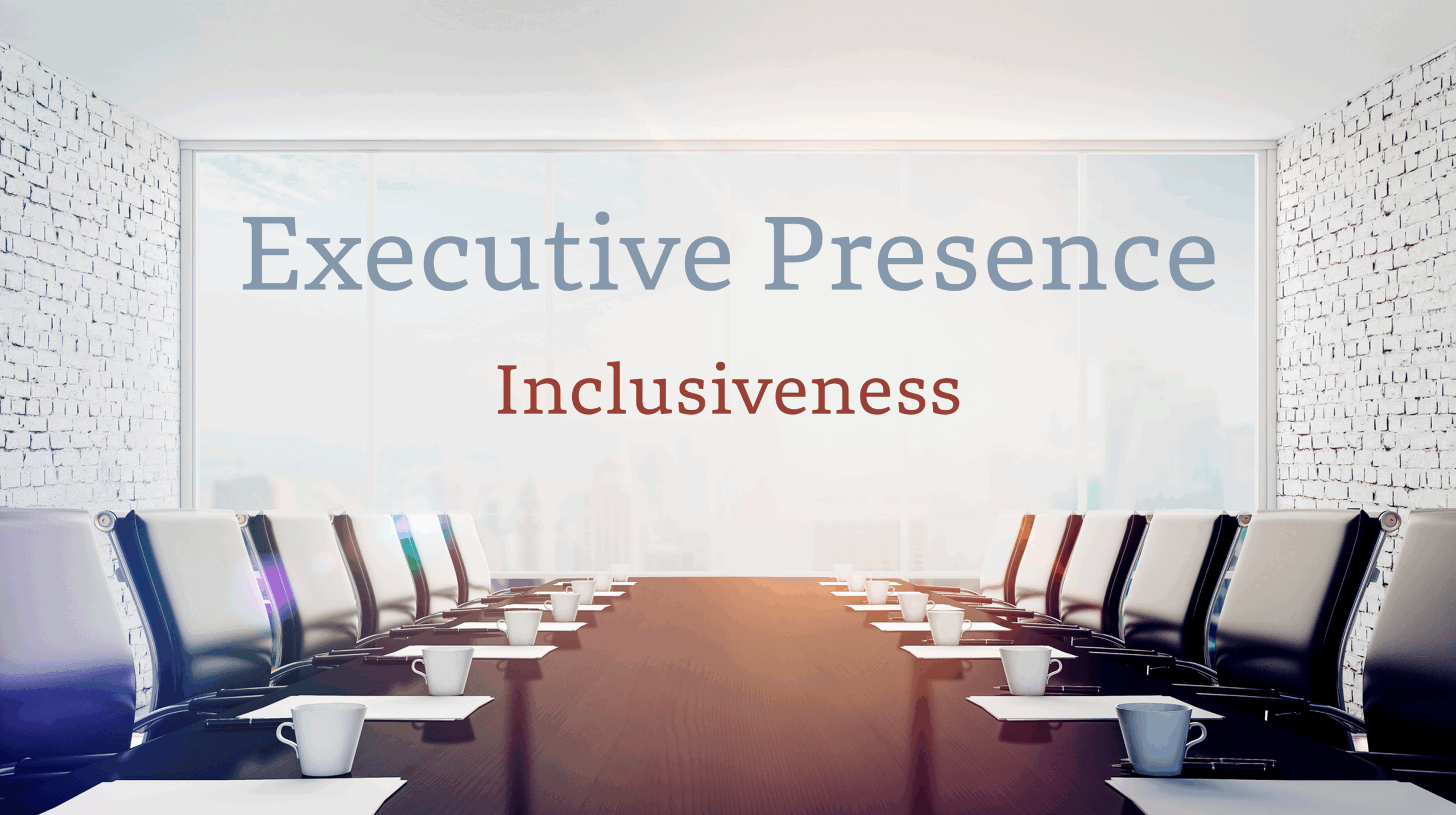
- Dale Ludwig Leadership
Inclusiveness is One of the Fifteen Facets of Executive Presence
This article is one in a series focusing on Executive Presence and how leaders can meet their potential through improved communication. Executive Presence is defined by Suzanne Bates in her book “All the Leader You Can Be: The Science of Achieving Extraordinary Executive Presence” as “The qualities of a leader that engage, inspire, align, and move people to act… By understanding how your intentions as a leader match up with perceptions, you can learn how to flex your style to gain trust, build alignment, lead change, inspire performance, and drive executional excellence.”
This article focuses on Inclusiveness, one of the 15 facets that make up a 3-dimensional leader.
Click here to gain a greater understanding of (a) executive presence in general and (b) the other facets that make up a well-rounded leader.
What is Inclusiveness?
Bates says someone who has a strength in Inclusiveness, one of the fifteen facets of executive presence, is good at “actively involving others, welcoming diverse points of view, encouraging ownership in mission, and empowering initiative.” Inclusiveness is about bringing people together and empowering them.
How Your Inclusiveness Makes People Feel
People with a strength in Inclusiveness instill a sense of comfort and belonging. They ask good questions, listen well, and make people feel part of the group. When a leader is Inclusive, people feel that:
- You respect my perspective.
- You trust me.
- You are patient and interested in what I think.
- You make me feel like a valued member of the team.
Not Enough Awareness of Inclusiveness
Someone who lacks Inclusiveness may withhold information from others and build silos separating groups from each other. As a result, they
- Fail to delegate tasks.
- Fail to identify high-potential individuals because they are not given a chance to prove themselves.
- Exclude and frustrate members of the team.
Specific Behaviors to Improve Perceptions of Your Inclusiveness
Here are some things you can do to improve your Inclusiveness.
- Make sure the right people are in the room.
- Give everyone an opportunity to talk during discussions.
- Ask good questions and show curiosity.
- Make people feel comfortable.
- Encourage collaboration.
- Delegate tasks without bias toward gender or marginalized individuals.
Too Much Emphasis on Your Inclusiveness
When someone exhibits too much of a particular facet, it can become an overstrength. An overstrength often results in negative perceptions. Here are some downsides of an overstrength in Inclusiveness.
- You may have too many cooks in the kitchen.
- You may experience analysis paralysis.
- Your meetings may be inefficient and waste time.
A Story About Purposeful Inclusiveness
“Kai, do you have a minute?” It was Stef from HR.
“I had a conversation with Heidi this morning. You and I need to talk.”
Kai’s team is a hybrid mix of people dispersed across North America. Five team members work at headquarters in Rockford, while the other five, including Heidi, are located elsewhere and work from home. The team members located near Rockford have the option to work from home two days a week. Kai never knows for sure where people are going to be, so meetings are always held over MS Teams. When more than one person is at HQ, they attend meetings together in a conference room.
Despite the clunkiness of hybrid meetings, Kei felt that this arrangement was the best way to deal with their “new normal.”
Stef asked, “Do you know the term proximity bias?” Kai answered that he did not.
“Proximity bias takes place when a manager shows a preference for those who are physically closer to them. This is not usually a conscious choice, but as a manager, you need to be aware of it, so you don’t unintentionally commit it.”
“Go on…” Kai said hesitantly.
Stef picked back up with his story, “Heidi says she’s been feeling this a lot lately. She said some of the other remote employees are feeling it too.”
As the conversation unfolded, Kai began to realize he had, in fact, been favoring the team members who worked out of HQ. “It’s just so easy to flag down Mike as he’s walking around the office. I know I can depend on him, and when things bubble up, he’s my go-to guy.”
“What about Sarah and Jens?” Stef asked. “You do the same with them, right?”
“Well, it’s just easier to talk with them since they’re always here than it is to pick up the phone or fire up a virtual meeting,” Kai said defensively. “Further, Heidi tends to be off camera, so she’s easy to forget about.”
“Yes, I fully understand that, but this preference for your in-house team, intentional or not, is wearing thin. Heidi says she feels left out, and she fears you no longer value her contributions. She said that you barely acknowledged the remote people’s presence in yesterday’s strategy meeting. She said she felt as if she was observing the meeting rather than participating in it.”
Kai felt awful. As the only out gay Asian at the company, he knows what it feels like to feel alienated and alone. Being seen as non-inclusive was the last thing he wanted. He told Stef that he’d fix the situation immediately.
It took some effort, but Kai became more inclusive and equitable when working with his team. The first thing he did was talk with Heidi and the other remote employees and apologize for committing proximity bias. He also decided to open up MS Teams 15 minutes before every staff meeting. This became an opportunity for everyone, regardless of where they were sitting, to log in and chat. The result is that since everyone can be seen and heard in an informal setting, this sense of togetherness spilled over into the “real” meeting.
The other thing he did was set expectations that the standard operating procedure is to have cameras on. It’s easy to assume that someone not on video is disengaged, which can lead to proximity bias. He explained that everyone has a responsibility to be seen and heard, and moving forward, that’s what he expects. When someone can’t be on video, assuming it’s a legitimate reason, everyone else will also go off camera as a way to level the playing field.
Some Facets Ride Together
Often, when we lean into particular facets (or pull back from them), other facets “come along for the ride.” Facets that can show improvement when leaders make an effort to be Inclusive include Authenticity, Integrity, Concern, Resonance, and Interactivity.
Final Thoughts About Inclusiveness
Inclusiveness is in the Style dimension in the Bates model, which means “it’s about the first impression people make—based on image, mannerisms, and interpersonal behavior.” Because the Style facets are all about the impression we make with our behaviors, we need to be self-aware and intentional about how we show up for others in both business and social situations.
If you’d like to learn more or explore executive presence coaching options for yourself or your team, click here to schedule a call.

